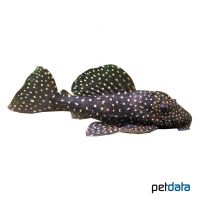Vampire Galaxy Pleco (Leporacanthicus galaxias)
| Vampire Galaxy Pleco Leporacanthicus galaxias | |
|---|---|
| Name | Vampire Galaxy Pleco |
| Name Lat. | Leporacanthicus galaxias |
| Synonym | L29 |
| Family | Suckermouth Armoured Catfishes |
| Family lat. | Loricariidae |
| Order | Catfishes |
| Order lat. | Siluriformes |
| Origin | Brazil |
| Habitat | Rivers |
| Diet | Carnivore |
| pH | 5.5-7.0 |
| Behavior | Nocturnal, peaceful |
| Keeping | Individual, pair, group |
| Care Level | Moderate |
| Reproduction | Cave spawner |
| Breeding | Difficult |
| Life Span | 10-15 years |
| Protection | No |
| Metric Units | |
| Size | 25 cm |
| Temperature | 22-25 °C |
| Hardness | 1-10 °dH |
| Aquarium | ~ 400 l |
| US Units | |
| Size | 10" |
| Temperature | 72-77 °F |
| Hardness | 18-178 ppm |
| Aquarium | ~ 100 gal |
Distribution and habitat
The crepuscular to nocturnal Milky Way Proboscis Catfish are found in some river systems in Brazil, such as the Rio Madeira, Tocantins and Guama. They inhabit deep burrows in the steep banks of streams and rivers, with round stones and roots, and also like to stay in the current.
Maintenance
The aquarium should have robust planting, with large round river pebbles, caves (clay tubes) and roots that provide hiding places as well as sufficient free swimming space. A substrate of sand and round gravel, some shaded light (e.g. floating plants) and a medium current is ideal.
No ammonia, ammonium and nitrite should be detectable, the nitrate value should not exceed 100 mg/l. To ensure the water quality and oxygen content, a filter and heater adapted to the aquarium size is required, as well as lighting for the species-appropriate day-night rhythm of the animals.
Diet
They feed on animal food. The food supply consists of live, frozen and dry food. For a balanced diet, feed once a day with a high-quality, protein-rich dry food for loricariids (granules, pellets, chips, tablets) as well as zooplankton, mosquito larvae, shrimp, krill, snails, fish, crab and mussel meat (live or frozen).
Only feed as much as will be eaten within a few minutes. Regular and varied feeding promotes health and increases resistance.
Behaviour and compatibility
It is recommended to keep them in pairs or in a small group. Keeping them in groups is only possible in a very large and richly structured tank. They behave very peacefully within the species as well as towards other fish and can be socialized well with South American tetras and cichlids, Corydoras as well as other loricariids
Basically, only compatible fish species with similar demands on water conditions and water temperature may be socialized.
Sex dimorphism
Sexually mature males have a broader head than females, strong pectoral spines on the first pectoral fin ray, and short, thick odontodes (pointed skin teeth) on the head and mouth margin.
Reproduction and breeding
There are only a few reports of successful breeding in the aquarium. They are cave breeders and the male does the brood care.
Important
The coloration of the points can vary from yellowish to white.
Aquarium plants basically do not serve them as food, but can be damaged or uprooted.
When catching, use as fine-meshed nets as possible so that the hard rays of the pectoral fins or the skin teeth (odontodes) do not get caught on the bone plates, which can cause painful puncture wounds when touched.
The well-being of the fish should be checked regularly. Temperature should be checked daily, pH, hardness and nitrate levels at least every 14 days. Regular partial water changes are recommended, even when contaminant levels have not yet reached the upper limit. Sudden changes in water quality should be avoided. Newly introduced fish must be accustomed slowly to the water in the aquarium.
Further literature can be found in your pet store.
References
Text: Werner Winter; Image: petdata
Source: BMELV (1998): Tierschutzgutachten - Haltung von Zierfischen (Süßwasser); BAENSCH & RIEHL (2004): Aquarien Atlas Bd. 3, Mergus Verlag; SCHMIDT, WERNER, LECHNER (2005): MiniAtlas L-Welse, Bede Verlag
- Gemäß § 21 Abs. 5 Tierschutzgesetz idgF
